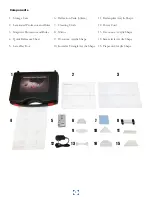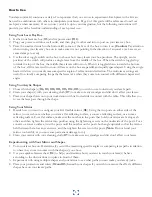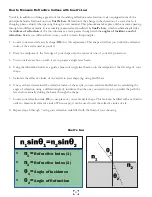
4
How to Measure Refractive Indices with Snell’s Law
Your kit, in addition to being a great tool for visualizing reflection and refraction, is also equipped to teach the
principle behind refraction known as
Snell’s Law.
Refraction is the change in the direction of a wave due to it
changing phase velocity when passing through a new material. This phenomena takes place with any waves passing
through two different media. It is accurately measured and predicted by
Snell’s Law
, which mathematically links
the
indices of refraction
of the two substances a wave passes through with the
angles of incidence and of
refraction.
Below you will read how to use your kit to learn this principle:
1. Locate your semi-circle acrylic shape (
#14
) for this experiment. This shape will allow you to find the refractive
index of the acrylic used in your kit.
2.
Place the midpoint of the flat edge of your shape onto the center of one of your kit’s protractors.
3. Turn your laser ray box on with it set to project a single laser beam.
4.
Using the illustration below as a guide, shine your single laser beam onto the midpoint of the flat edge of your
shape.
5. Calculate the refractive index of the acrylic in your shape (
n
2
) using Snell’s Law.
6.
Once you have determined the refractive index of the acrylic, you can confirm Snell’s Law by calculating the
angle of refraction using a different angle of incidence than the one you used in step 4 to predict the path the
laser before actually shining the beam through the shape.
7. Locate your refraction tank (
#6
) to use place of your semi-circle shape. This tank can be filled with any fluid in
order to measure its refractive index. When empty, it can be used to test the refractive index of air.
8.
Repeat steps 4 through 7 using your refraction tank filled with the fluid of your choosing.
Snell’s Law
• n
1
=
Refractive Index (1)
• n
2
=
Refractive Index (2)
•
θ
1
=
Angle of Incidence
•
θ
2
=
Angle of Refraction





